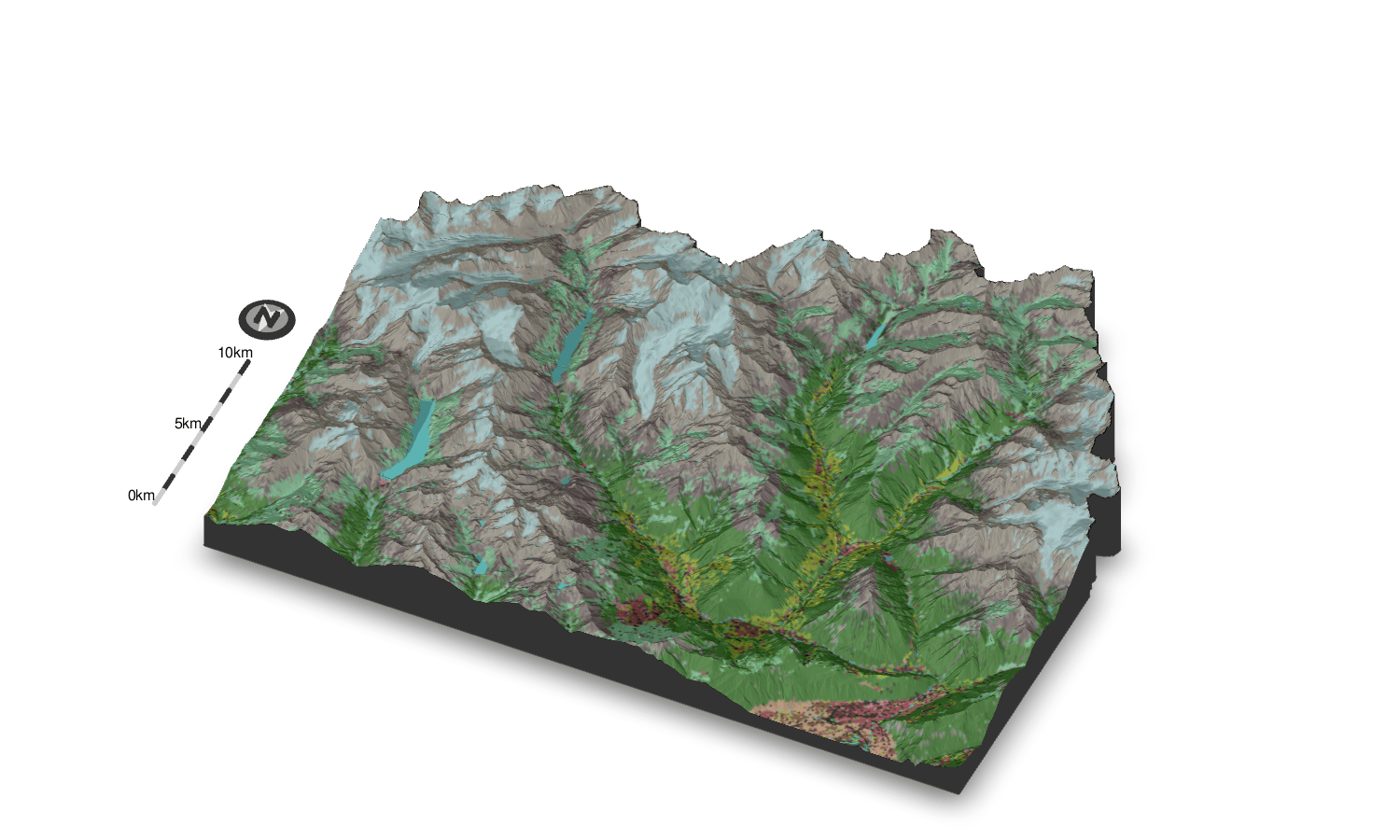+4°C, Swiss landscapes under four degrees climate warming
Reports | Visualisations | Videos | Swiss Federal Office For the Environment | Watson News | Les Temps | Interview on CANAL9
 |
 |
Project summary
The following text is a GPT3 translation of the summary at the beginning of the French version of the official project report.
The landscape, in its diversity, is an important resource for Switzerland and strongly influences the quality of human life. However, possible changes to landscapes due to climate change, and consequently the impacts on humans, have hardly been addressed so far. This project has developed and presented different scenarios on how climate change could affect the landscape. Its objective was to raise awareness in society about the effects of climate change on the landscape. The approach assumes a relatively significant global warming that poses high risks to humans and the environment. The chosen scenario predicts an average temperature increase of about 4 °C compared to the average temperature between 1981 and 2010. It represents situations where the goals of the 2015 Paris Agreement on climate are not achieved.
A literature review and expert interviews allowed us to develop a qualitative impact model based on which we deduced scenarios for landscape evolution under much warmer climatic conditions. On the other hand, we modeled changes in land use potential and the composition of plant communities using quantitative methods.
The focus was on two typical Swiss landscape examples, one in a mountainous region and the other in the Middle Country. We chose the Entremont region (VS) to represent the Swiss Alps and the Bernese Seeland (BE) for the Middle Country. Modeling was largely done for the entire Switzerland, with detailed considerations made for the two study regions.
Current climate scenarios for Switzerland (CH2018) from the National Centre for Climate Services (NCCS) served as the basis for landscape scenarios. To draw attention to the risks associated with climate change, we chose the RCP8.5 scenario, which envisions a general warming of 4°C compared to the period 1981–2010. We considered two different climate change adaptation strategies: purely reactive and short-term measures planning, and proactive measures planning anticipating warming impacts.
The impact models developed in the project revealed that Swiss landscapes will undergo significant changes due to climate change. In mountain regions, the disappearance of glaciers and the elevation of the tree line and vegetation will be the most striking landscape changes. Due to the modification of climatic vegetation conditions, species composition in forests will change everywhere. In the Middle Country, beeches and conifers will no longer find favorable living conditions due to drought and will migrate to higher altitudes. In Middle Country forests, deciduous species should be favored as future main species. If easily flammable conifers (e.g., pines) establish themselves at higher altitudes, the risk of forest fires could increase in the Jura and the Alps.
In general, the situation regarding natural risks will evolve. In mountain regions, more landslides and rockfalls can be expected, but fewer avalanches, while in the Middle Country, floods will more frequently threaten inhabited areas, infrastructure, and farmland. The influence of natural hazards on the landscape will depend on the strategies chosen to protect against these threats. Massive retaining walls and high dikes create a different landscape than slopes with protective forests and river widenings, the latter occupying larger areas.
The future appearance of residential areas and farmland will also depend significantly on how public policies and society adapt to climate change. Dwellings may be dotted with green spaces and open water plans to mitigate heat, or conversely, emphasis may be placed on cooled indoor spaces, recognizable by air conditioners installed on buildings. In the case of farmland, climate change adaptation strategies will be decisive for the future landscape. The development of drought-resistant crops, extensive irrigation systems, and large greenhouse installations for crops will have a considerable impact on the landscape.
Many of these landscape-impacting climate change adaptation measures must be planned and implemented early enough to be effective in a modified climate. This includes measures such as adapting forests to climate change, redesigning urban areas, and measures to protect against natural hazards. Therefore, we should focus on climate change adaptation from today. However, it should be noted that this project is based on the assumption that greenhouse gas emissions will continue to increase. Measures to mitigate climate change and their effects on the landscape have not been considered, but they are just as important as adaptation measures.
To meet the requirement of raising awareness of the consequences of climate change, scenarios were written in the form of narratives. These describe walks through summer landscapes in mountain regions and the Middle Country in a much warmer future. In addition, great importance was given to visualizing possible future landscapes. In addition to different maps resulting from quantitative modeling, interactive 360° panoramic images were created for the two chosen landscapes. They show a panoramic view of possible future landscape states if a reactive or proactive climate change adaptation strategy is chosen. Some details are explained in information windows that open when clicked. To draw attention to the interactive panoramic images and this report, two short videos were also produced, one for the Middle Country and the other for mountain regions.
Links
- Project report in German
- Project report in French
- Visualisations
- Models repository
- Scientific publication available soon